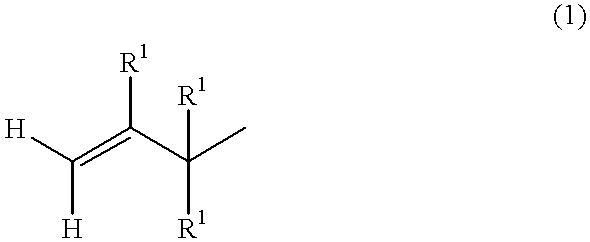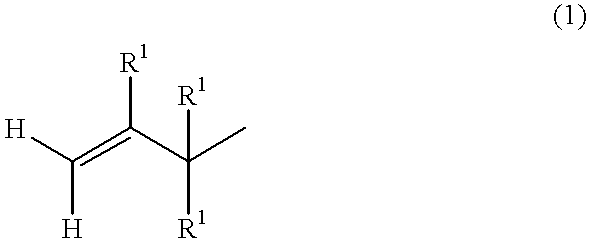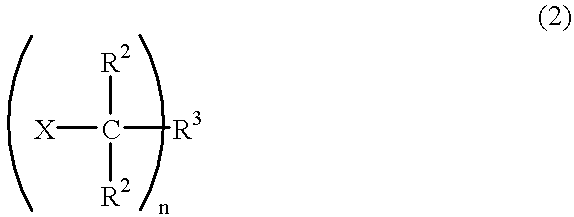Alkenyl-containing isobutylene group block copolymer and process for producing it
a technology copolymer, which is applied in the field of isobutylene group block, can solve the problems of insufficient introduction rate of alkenyl group, insufficient impact resistance and mechanical strength, and insufficient enhancing reaction rate, etc., and achieves high reactivity, high reactivity, and easy production
- Summary
- Abstract
- Description
- Claims
- Application Information
AI Technical Summary
Benefits of technology
Problems solved by technology
Method used
Image
Examples
example 1
The polymerization vessel of a 500 mL separable flask, after nitrogen purging, was charged with 120 mL of n-hexane (dehydrated with molecular sieves), 80 mL of methylene chloride (dehydrated with molecular sieves) using a syringe, and 0.0876 g (0.38 mmol) of p-dicumyl chloride. The polymerization vessel was cooled in a dry ice / methanol bath at -70.degree. C. and 0.036 g (0.39 mmol) of 2-methylpyridine was added. Then, a Teflon delivery tube was connected to a pressure-resistant glass liquefaction tube equipped with a 3-way cock and containing 33.9 mL (419.9 mmol) of isobutylene monomer component, and isobutylene group monomer component was fed under nitrogen pressure to the polymerization vessel. Then, 1.50 mL (13.7 mmol) of titanium tetrachloride was added for initiation of polymerization. After 1 hour of stirring at the same temperature after beginning of polymerization, about 1 mL of the polymer slurry was withdrawn for sampling purposes. Then, a mixture of 12.15 g (116.7 mmol) o...
example 2
Except that the amount of p-dicumyl chloride was set at 0.35 g (1.52 mmol) and that of 2-methylpyridine at 0.072 g (0.78 mmol), the procedure of Example 1 was otherwise repeated.
GPC analysis of the resulting block copolymer showed that, whereas the number average molecular weight and molecular weight distribution of isobutylene group polymer before addition of styrene were Mn=18000 and Mw / Mn=1. 22, respectively, the corresponding values of the block copolymer after polymerization of styrene were Mn=26000 and Mw / Mn=1.38, respectively.
The integrated intensity ratio of isobutylene group and that of allyl on the .sup.1 H-NMR spectrum of the resulting block copolymer suggested that an average of 1.7 allyl groups had been introduced per polymer molecule.
example 3
A 200 mL four-necked flask equipped with a condenser was charged with 10.0 g of the block copolymer obtained in Example 2, 50 mL of toluene, 1.8.times.10.sup.-3 mmol of platinum divinyltetramethyldisiloxane complex (dissolved in xylene), and 0.85 g (0.8 mmol) of dimethoxymethylsilane, and the charge was stirred at 80.degree. C. for 10 hours to undergo hydrosilylation of the block copolymer. The reaction mixture was then poured in 200 mL of methanol to provide a reactive-silicon-group-containing isobutylene group block copolymer.
The integrated intensity ratio of isobutylene group and that of methyl of the silicon on the .sup.1 H-NMR spectrum of the above polymer suggested that an average of 1.3 dimethoxymethylsilyl groups had been introduced per polymer molecule.
PUM
| Property | Measurement | Unit |
|---|---|---|
| temperature | aaaaa | aaaaa |
| weight % | aaaaa | aaaaa |
| weight % | aaaaa | aaaaa |
Abstract
Description
Claims
Application Information
 Login to View More
Login to View More - R&D
- Intellectual Property
- Life Sciences
- Materials
- Tech Scout
- Unparalleled Data Quality
- Higher Quality Content
- 60% Fewer Hallucinations
Browse by: Latest US Patents, China's latest patents, Technical Efficacy Thesaurus, Application Domain, Technology Topic, Popular Technical Reports.
© 2025 PatSnap. All rights reserved.Legal|Privacy policy|Modern Slavery Act Transparency Statement|Sitemap|About US| Contact US: help@patsnap.com



